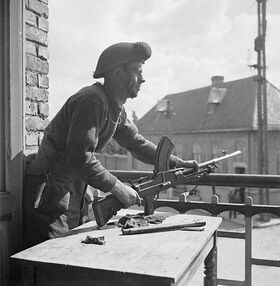Battle of Kongberg
This article is incomplete because it is pending further input from participants, or it is a work-in-progress by one author. Please comment on this article's talk page to share your input, comments and questions. Note: To contribute to this article, you may need to seek help from the author(s) of this page. |
| Battle of Kongberg | |||||||
|---|---|---|---|---|---|---|---|
| Part of the Scandinavia Campaign of the Seleucid Uprising | |||||||
 An Erebonian Brnfield Gunner in Kongsberg | |||||||
| |||||||
| Belligerents | |||||||
|
Allied Security Forces
Other Allied Nations: | |||||||
| Commanders and leaders | |||||||
| |||||||
| Strength | |||||||
|
1,150,000 troops 2,750 guns 850 tanks 1,115 aircraft |
1,500,250 troops 3,000 guns 1,050 tanks 952 aircraft | ||||||
| Casualties and losses | |||||||
|
By February 1953:
|
By February 1953:
| ||||||
The Battle of Kongsberg (23 August 1952 - 2 February 1953) was a major battle that occurred in the Scandinavia Campaign during the Selucid Uprising. It was here where the Selucids attempted to gain a foothold in Western Erebonia by occupying the port city of Kongsberg, and from there, carry out the invasion of Western Erebonia while keeping its own forces supplied through the Gulf of Kongsberg. Marked by fierce close-quarters combat and direct assaults on civilians in air raids, it is one of the bloodiest battles of the war, with an estimated 1 million killed or wounded. After their defeat at Kongsberg, the Deseleni High Command was forced off Western Erebonia, and shifting its attention in a one final attempt to retake Heimdallr during Case Eumenes.
The Deseleni offensive to capture Kongsberg-a major industrial, mining, and transport hub on the Gulf of Kongsberg that ensured Allied access to the Western Erebonian oil and mining regions began in August 1952, using the 6th Army and the 4th Panzer Army. The attack was supported by intense Luftwaffe bombing that destroyed 50% of the city. The battle degenerated into house-to-house fighting as both sides poured reinforcements into the city. By mid-November, the Selucids had maintained control of the city.
In 15 November, elements of the Royal Navy and the Royal Erebonian Navy engaged with the Imperial Kriegsmarine at the Battle of Kongsburg Gulf. Here, Allied Navies managed to sever Imperial supply route through the sea, robbing the Imperials of any sort of supply. As a result, the Imperials were forced to carry out supply by air. By 21 November, the Allied forces launched Operation Mattress, a two-pronged attack targeting the weaker Selucid auxiliary forces protecting the 6th Army's flanks. The Imperial flanks were overrun and the 6th Army was cut off and surrounded in Kongsberg. Maximillian I was determined to hold the city at all cost and forbade the 6th Army from attempting a breakout; instead, attempts were made to supply it by air and to break the encirclement by sailing reinforcements across the gulf. Heavy fighting continued for two more months. By 1 January 1953, the Allies had defeated the last Deseleni ships attempting to reinforce the 6th Army and began the naval blockade. At the beginning of February 1953, the commander of the 6th Army, General Sascha Gehrig surrendered all Imperial Deseleni forces in and around Kongsberg after exhausting their ammunition and food after nearly six months of hard fighting.
The loss at Kongsberg forced the Deseleni High Command to cancel all future plans for invading Western Erebonia.